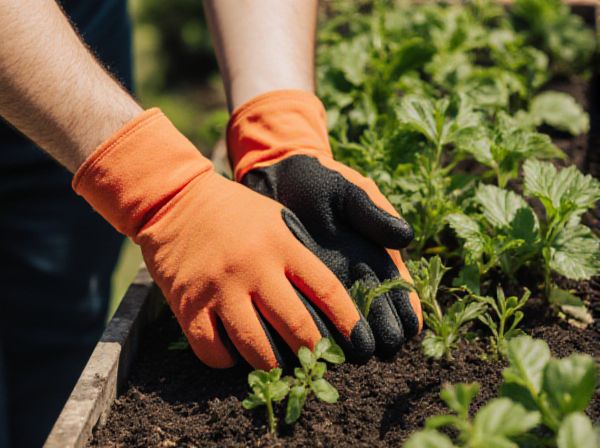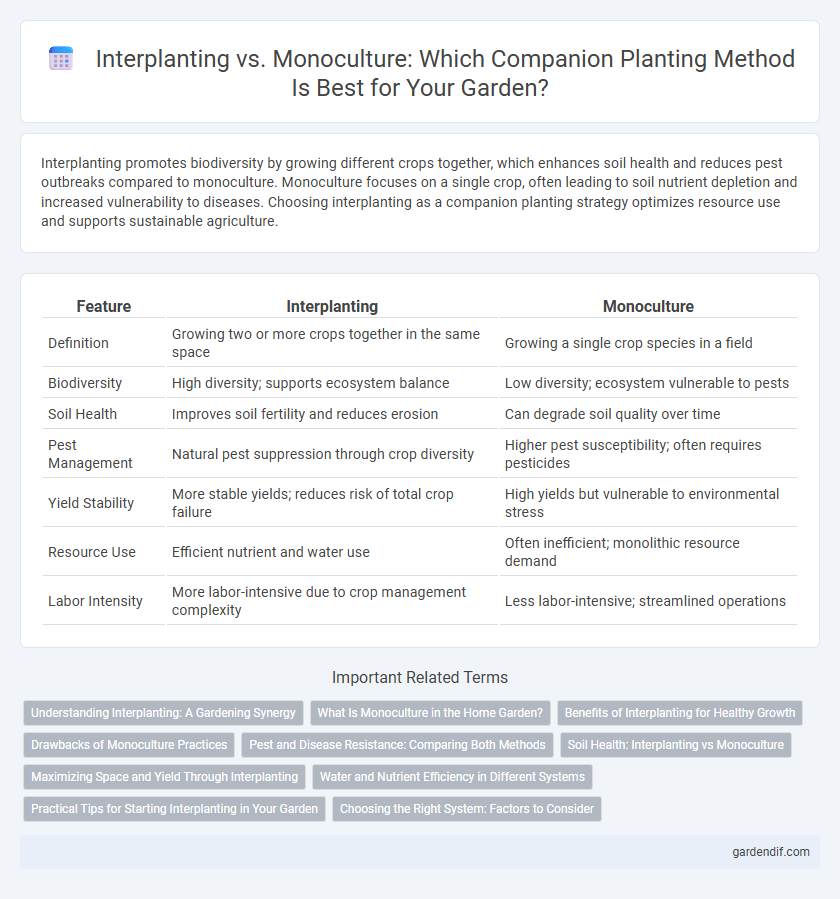
Interplanting vs Monoculture Illustration
Interplanting promotes biodiversity by growing different crops together, which enhances soil health and reduces pest outbreaks compared to monoculture. Monoculture focuses on a single crop, often leading to soil nutrient depletion and increased vulnerability to diseases. Choosing interplanting as a companion planting strategy optimizes resource use and supports sustainable agriculture.
Table of Comparison
| Feature | Interplanting | Monoculture |
|---|---|---|
| Definition | Growing two or more crops together in the same space | Growing a single crop species in a field |
| Biodiversity | High diversity; supports ecosystem balance | Low diversity; ecosystem vulnerable to pests |
| Soil Health | Improves soil fertility and reduces erosion | Can degrade soil quality over time |
| Pest Management | Natural pest suppression through crop diversity | Higher pest susceptibility; often requires pesticides |
| Yield Stability | More stable yields; reduces risk of total crop failure | High yields but vulnerable to environmental stress |
| Resource Use | Efficient nutrient and water use | Often inefficient; monolithic resource demand |
| Labor Intensity | More labor-intensive due to crop management complexity | Less labor-intensive; streamlined operations |
Understanding Interplanting: A Gardening Synergy
Interplanting enhances garden biodiversity by combining compatible plant species within the same space to promote natural pest control and improved soil health. This synergy contrasts with monoculture, where a single crop dominates, often leading to increased vulnerability to pests and nutrient depletion. Understanding interplanting benefits gardeners by optimizing space, boosting plant growth, and reducing the need for chemical interventions.
What Is Monoculture in the Home Garden?
Monoculture in the home garden involves planting a single crop species over a large area, which can simplify management but often leads to soil nutrient depletion and increased susceptibility to pests and diseases. This practice contrasts with interplanting, where multiple plant species grow together to promote biodiversity and improve ecosystem resilience. Relying solely on monoculture may reduce overall garden health and requires careful attention to soil amendments and pest control measures.
Benefits of Interplanting for Healthy Growth
Interplanting enhances soil health by promoting biodiversity and natural pest control, reducing the need for chemical inputs. Different plant species support each other's growth through nutrient sharing and improved microclimate conditions. This method increases crop resilience, leading to higher yields and sustainable, healthy plant development.
Drawbacks of Monoculture Practices
Monoculture practices lead to significant drawbacks such as increased vulnerability to pests and diseases due to genetic uniformity, resulting in higher pesticide use and reduced biodiversity. Soil depletion occurs rapidly under monoculture, as the same crop continuously extracts the same nutrients, causing long-term fertility loss. This approach also diminishes ecosystem resilience, making agricultural systems more susceptible to climate fluctuations and environmental stressors.
Pest and Disease Resistance: Comparing Both Methods
Interplanting enhances pest and disease resistance by increasing biodiversity, which disrupts pest habitats and reduces the spread of pathogens. Monoculture, while easier to manage, often creates a vulnerable environment where pests and diseases can rapidly proliferate due to the uniformity of crops. Studies show that interplanting can lower pest populations by up to 30%, improving overall plant health without reliance on chemical pesticides.
Soil Health: Interplanting vs Monoculture
Interplanting enhances soil health by promoting biodiversity and improving nutrient cycling, reducing the risk of soil depletion and erosion compared to monoculture systems. Monoculture often leads to soil degradation due to repetitive planting of a single crop, which exhausts specific nutrients and decreases microbial diversity. Incorporating diverse plant species in interplanting supports beneficial soil organisms and enhances organic matter content, fostering sustainable soil fertility.
Maximizing Space and Yield Through Interplanting
Interplanting maximizes space and yield by growing compatible crops together, allowing multiple plants to share the same area efficiently. This method improves soil health, reduces pest pressure, and increases overall productivity compared to monoculture, which dedicates all space to a single crop. By utilizing vertical layers and complementary growth cycles, interplanting enhances resource use and biodiversity on limited land.
Water and Nutrient Efficiency in Different Systems
Interplanting enhances water and nutrient efficiency by allowing complementary root structures and nutrient uptake patterns, reducing competition and improving soil moisture retention compared to monoculture systems. Diverse plant species in interplants optimize resource use through symbiotic relationships, such as nitrogen fixation by legumes benefiting neighboring crops. In contrast, monoculture often leads to nutrient depletion and inefficient water use, necessitating higher external inputs for crop growth.
Practical Tips for Starting Interplanting in Your Garden
Interplanting enhances biodiversity and pest control by combining compatible plants like tomatoes with basil or carrots with onions in the same garden bed. To start, choose crops with differing nutrient needs and growth habits, ensuring adequate spacing to minimize competition and maximize sunlight exposure. Regularly monitor soil moisture and use mulch to retain hydration, promoting healthy growth in your interplanted garden system.
Choosing the Right System: Factors to Consider
Choosing between interplanting and monoculture depends on factors such as crop compatibility, soil health, pest management, and available space. Interplanting enhances biodiversity and can improve yield resilience by combining complementary plant species, while monoculture simplifies management and suits large-scale uniform crop production. Assessing climate conditions, labor availability, and market demands ensures the selection of the optimal planting system.
Interplanting vs Monoculture Infographic

 gardendif.com
gardendif.com